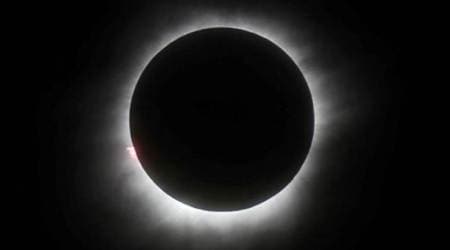 It also helps that this particular eclipse will be visible over much of the U.S., a country full of scientists and science enthusiasts. A total eclipse will be visible through a 70-mile-wide band running from Oregon to South Carolina. (File Photo)
It also helps that this particular eclipse will be visible over much of the U.S., a country full of scientists and science enthusiasts. A total eclipse will be visible through a 70-mile-wide band running from Oregon to South Carolina. (File Photo)
By Faye Flam/Bloomberg
During next Monday’s solar eclipse, a shadow will rush across the sky at 1,500 miles an hour, creating a cold spot that will ripple the atmosphere like a speedboat stirring up a bow wake. One group of atmospheric scientists is headed to Missouri, where they’ll borrow people’s backyards to study the phenomenon. Other researchers plan to observe the sun’s mysterious atmosphere, known as the corona, which is normally drowned out by sunlight. To that end, NASA is flying two retrofitted bomber jets equipped with telescopes through the eclipse path.
Solar eclipses happen every couple of years somewhere in the world, yet scientists never run out of new ways to learn from them. Every one is a unique natural experiment, and each time around, new technologies allow things that weren’t possible before. It also helps that this particular eclipse will be visible over much of the U.S., a country full of scientists and science enthusiasts. A total eclipse will be visible through a 70-mile-wide band running from Oregon to South Carolina.
Scientists have been using eclipses to learn about the universe for at least 200 years, according to Jay Pasachoff, an astronomy professor at Williams College in Massachusetts. He’s been among them for 65 eclipses, and for his 66th, he’s headed to Salem, Oregon, with a team of astronomers from around the world and a truck loaded with 3,000 pounds of equipment. He’s planning to collect new data on the way charged particles in the corona follow loops of magnetic field.
Big advances have come from past eclipses. The most famous was the 1919 eclipse, when Arthur Eddington demonstrated that the sun’s mass did indeed bend starlight as predicted by Einstein’s theory of relativity. But long before that, in 1868, astronomers observing an eclipse in India made another historic discovery. Using instruments to separate the sun’s light into a spectrum of colors, Pasachoff said, they found evidence of a mysterious, as-yet-undiscovered element in the sun’s corona. In honor of the Greek god of the sun, they dubbed the new element “helium.”
Astronomers thought they’d discovered yet another element during an eclipse the next year, said Pasachoff. But they eventually realized the substance they dubbed “coronium” was in fact something else: iron in the sun’s atmosphere that had been heated to an improbable temperature above a million degrees. To this day scientists are still trying to understand why the sun’s atmosphere is so hot – a thousand times hotter than the surface, which is only a few thousand degrees. That’s the main mystery that Pasachoff is trying to solve with his team.
Scientists have some ideas about how the sun could send so much heat to the corona, said Amir Caspi, a solar physicist at the Southwest Research Institute. According to one, the magnetic field creates a kind of wave that transfers energy from the sun’s interior to the much less dense envelope of gas. In another theory, numerous small “nanoflares” transfer energy to the corona – although observations so far have only revealed hints that they exist. To look for these two phenomena, Caspi is involved in a NASA project using two Cold War-era bombers called WB-57s outfitted with telescopes.
Flying at 50,000 feet – a bit above normal commercial cruising altitude – they won’t have to worry about clouds, and they can measure infrared light, which from the ground is mostly blocked by the atmosphere. They will take about 30 images a second of the corona, generating a wealth of data. And by flying along the shadow’s path, they’ll get to spend about four full minutes viewing the total eclipse. The best you can get on the ground is a little more than two and a half. (The record for long-duration eclipse viewing occurred in 1973, when the Concorde flew at supersonic speeds along the eclipse path, giving passengers 74 minutes of totality.)
Meanwhile, electrical engineering professor Josh Semeter of Boston University is leading one of the groups studying the way the shadow of the eclipse will ruffle the atmosphere. The moon’s shadow moves west to east because the moon moves that direction in its orbit. The shadow of the moon will create a disturbance – a sort of wake that Semeter and his colleagues plan to observe by bouncing radio waves off the charged particles of the upper atmospheric layer known as the ionosphere.
“One state that has a beautiful set of sensors already in place is Missouri,” Semeter said. These are GPS receivers put up by the department of transportation. But they also want to get a more fine-grained set of measurements, from sensors spaced closer together. For that, they realized they’d need to borrow some backyards to set up smaller receivers. A newspaper story asked for people between Jefferson City and Springfield to volunteer, and they got more than enough responses, he said – enough to cherry pick the best spots.
While they’re taking advantage of GPS technology, Semeter said one application of their work will be to improve their models of the ionosphere, which can help improve future GPS accuracy and prevent signal loss from fluctuations in all those charged particles. And they expect to see other effects. The moon’s shadow will temporarily alter the ionosphere, allowing some of the charged particles and free electrons to combine into neutral atoms. Plus, the fact that the shadow moves at supersonic speeds means they could get some interesting shock waves, created the same way supersonic planes create sonic booms. “I can’t tell you exactly what effects we’ll see because this is research,” Semeter said. “We have no precedent for these kinds of detailed observations.”
Another unprecedented phenomenon during this eclipse will be the large numbers of everyday people helping researchers gather data. Citizen scientists can help NASA record weather conditions using the GLOBE Observer app, or contribute photos to a collective effort called the Eclipse Megamovie, or download iNaturalist and record noteworthy animal behavior. It’s estimated that millions of people will participate in such efforts. Plus, we won’t have to wait too long for the next eclipse to grace the continental United States. That will happen in 2024, by which time technology will allow a whole new world of possibilities.

